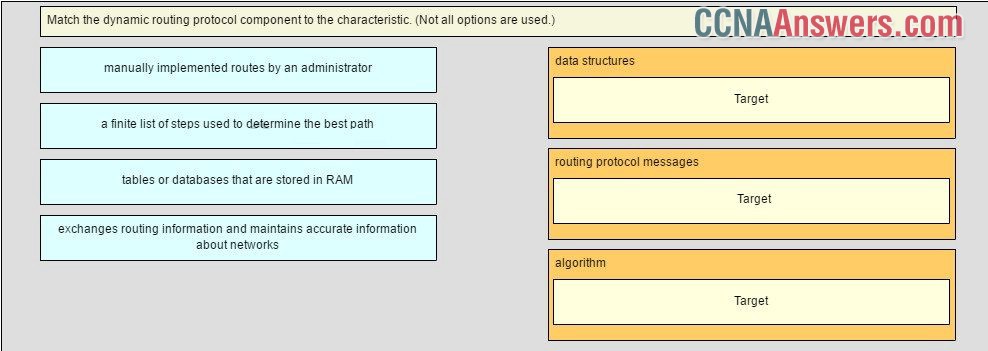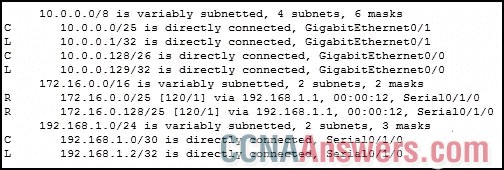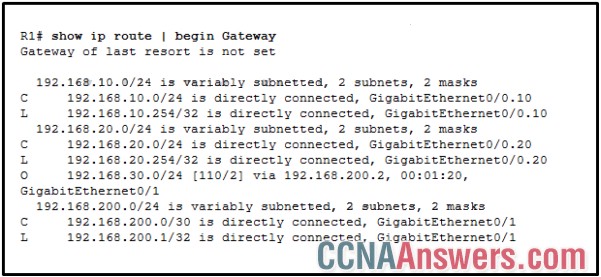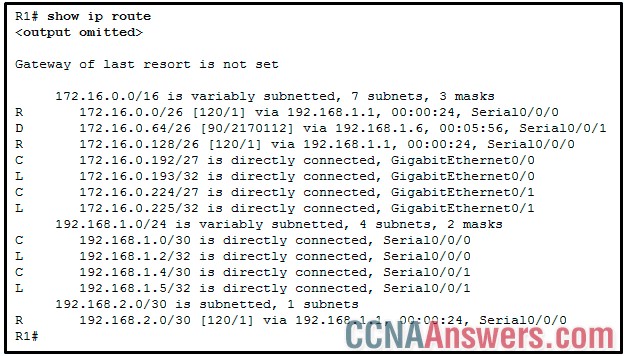CCNA 2 Chapter 3 V6.0 Answers
1. What is a purpose of the network command when configuring RIPv2 as the routing protocol?
It identifies the interfaces that belong to a specified network.
It specifies the remote network that can now be reached.
It populates the routing table with the network entry.
It immediately advertises the specified network to neighbor routers with a classful mask.
2. A network administrator configures a static route on the edge router of a network to assign a gateway of last resort. How would a network administrator configure the edge router to automatically share this route within RIP?
Use the default-information originate command.
Use the passive-interface command.
Use the auto-summary command.
Use the network command.
3. Which route would be automatically created when a router interface is activated and configured with an IP address?
C 192.168.0.0/24 is directly connected, FastEthernet 0/0
S 192.168.1.0/24 is directly connected, FastEthernet 0/1
D 10.16.0.0/24 [90/3256] via 192.168.6.9
O 172.16.0.0/16 [110/65] via 192.168.5.1
4. Match the dynamic routing protocol component to the characteristic. (Not all options are used.)

data structures -> tables or databases that are stored in RAM
routing protocol messages -> exchanges routing information and maintains accurate information about networks
algorithm -> a finite list of steps used to determine the best path
5. While configuring RIPv2 on an enterprise network, an engineer enters the command network 192.168.10.0 into router configuration mode. What is the result of entering this command?
The interface of the 192.168.10.0 network is sending RIP hello messages.
The interface of the 192.168.10.0 network is sending only version 2 updates.
The interface of the 192.168.10.0 network is sending version 1 and version 2 updates.
The interface of the 192.168.10.0 network is receiving version 1 and version 2 updates.
6. Which two requirements are used to determine if a route can be considered as an ultimate route in a router’s routing table? (Choose two.)
contain subnets
be a default route
contain a next-hop IP address
contain an exit interface
be a classful network entry
7. What is the purpose of the passive-interface command?
allows an interface to remain up without receiving keepalives
allows a router to receive routing updates on an interface but not send updates via that interface
allows a routing protocol to forward updates out an interface that is missing its IP address
allows interfaces to share IP addresses
allows a router to send routing updates on an interface but not receive updates via that interface
8. What two tasks do dynamic routing protocols perform? (Choose two.)
propagate host default gateways
network discovery
assign IP addressing
update and maintain routing tables
discover hosts
9. A router is configured to participate in multiple routing protocol: RIP, EIGRP, and OSPF. The router must send a packet to network 192.168.14.0. Which route will be used to forward the traffic?
a 192.168.14.0/25 route that is learned via RIP
a 192.168.14.0/25 route that is learned via OSPF
a 192.168.14.0/24 route that is learned via EIGRP
a 192.168.14.0/26 route that is learned via RIP
10. Refer to the exhibit. Based on the partial output from the show ip route command, what two facts can be determined about the RIP routing protocol? (Choose two.)

RIP version 2 is running on this router and its RIP neighbor.
RIP version 1 is running on this router and its RIP neighbor.
The command no auto-summary has been used on the RIP neighbor router.
The metric to the network 172.16.0.0 is 120.
RIP will advertise two networks to its neighbor.
11. What occurs next in the router lookup process after a router identifies a destination IP address and locates a matching level 1 parent route?
The level 1 ultimate routes are examined.
The level 2 child routes are examined.
The router drops the packet.
The level 1 supernet routes are examined.
12. Which two statements are true regarding classless routing protocols? (Choose two.)
sends subnet mask information in routing updates
sends complete routing table update to all neighbors
reduces the amount of address space available in an organization
allows for use of both 192.168.1.0/30 and 192.168.1.16/28 subnets in the same topology
is supported by RIP version 1
13. Which dynamic routing protocol was developed to interconnect different Internet service providers?
RIP
BGP
EIGRP
OSPF
14. What is different between IPv6 routing table entries compared to IPv4 routing table entries?
IPv6 routing tables include local route entries which IPv4 routing tables do not.
IPv6 does not use static routes to populate the routing table as used in IPv4.
By design IPv6 is classless so all routes are effectively level 1 ultimate routes.
The selection of IPv6 routes is based on the shortest matching prefix, unlike IPv4 route selection which is based on the longest matching prefix.
15. What is a disadvantage of using dynamic routing protocols?
They require administrator intervention when the pathway of traffic changes.
They are only suitable for simple topologies.
They send messages about network status insecurely across networks by default.
Their configuration complexity increases as the size of the network grows.
16. Which type of route will require a router to perform a recursive lookup?
A parent route on a router that is using CEF
a level 1 network route that is using a next hop IP address on a router that is using CEF
a level 2 child route that is using an exit interface on a router that is not using CEF
an ultimate route that is using a next hop IP address on a router that is not using CEF
17. Which route would be used to forward a packet with a source IP address of 192.168.10.1 and a destination IP address of 10.1.1.1?
O 10.1.1.0/24 [110/65] via 192.168.200.2, 00:01:20, Serial0/1/0
S* 0.0.0.0/0 [1/0] via 172.16.1.1
C 192.168.10.0/30 is directly connected, GigabitEthernet0/1
S 10.1.0.0/16 is directly connected, GigabitEthernet0/0
18. When would it be more beneficial to use a dynamic routing protocol instead of static routing?
in an organization where routers suffer from performance issues
on a stub network that has a single exit point
on a network where there is a lot of topology changes
in an organization with a smaller network that is not expected to grow in size
19. A destination route in the routing table is indicated with a code D. Which kind of route entry is this?
a route used as the default gateway
a static route
a route dynamically learned through the EIGRP routing protocol
a network directly connected to a router interface
20. Which routing protocol is limited to smaller network implementations because it does not accommodate growth for larger networks?
IS-IS
RIP
OSPF
EIGRP
21. Refer to the exhibit. Which two types of routes could be used to describe the 192.168.200.0/30 route? (Choose two.)

level 1 network route
level 1 parent route
supernet route
ultimate route
level 2 child route
22. When would it be more beneficial to use static routing instead of dynamic routing protocols?
on a network that is expected to continually grow in size
on a network that commonly experiences link failures
on a network where dynamic updates would pose a security risk
on a network that has a large amount of redundant paths
23. Which route is the best match for a packet entering a router with a destination address of 10.16.0.2?
S 10.0.0.0/8 [1/0] via 192.168.0.2
S 10.16.0.0/24 [1/0] via 192.168.0.9
S 10.16.0.0/16 is directly connected, Ethernet 0/1
S 10.0.0.0/16 is directly connected, Ethernet 0/0
24. Refer to the exhibit. Which interface will be the exit interface to forward a data packet with the destination IP address 172.16.0.66?

GigabitEthernet0/1
GigabitEthernet0/0
Serial0/0/0
Serial0/0/1
25. Match the characteristic to the corresponding type of routing. (Not all options are used.)

Place the options in the following order:
[+] typically used on stub networks
[+] less routing overhead
[#] new networks are added automatically to the routing table
[#] best choice for large networks


Leave a Reply